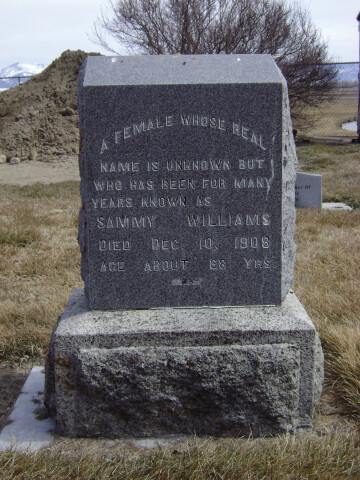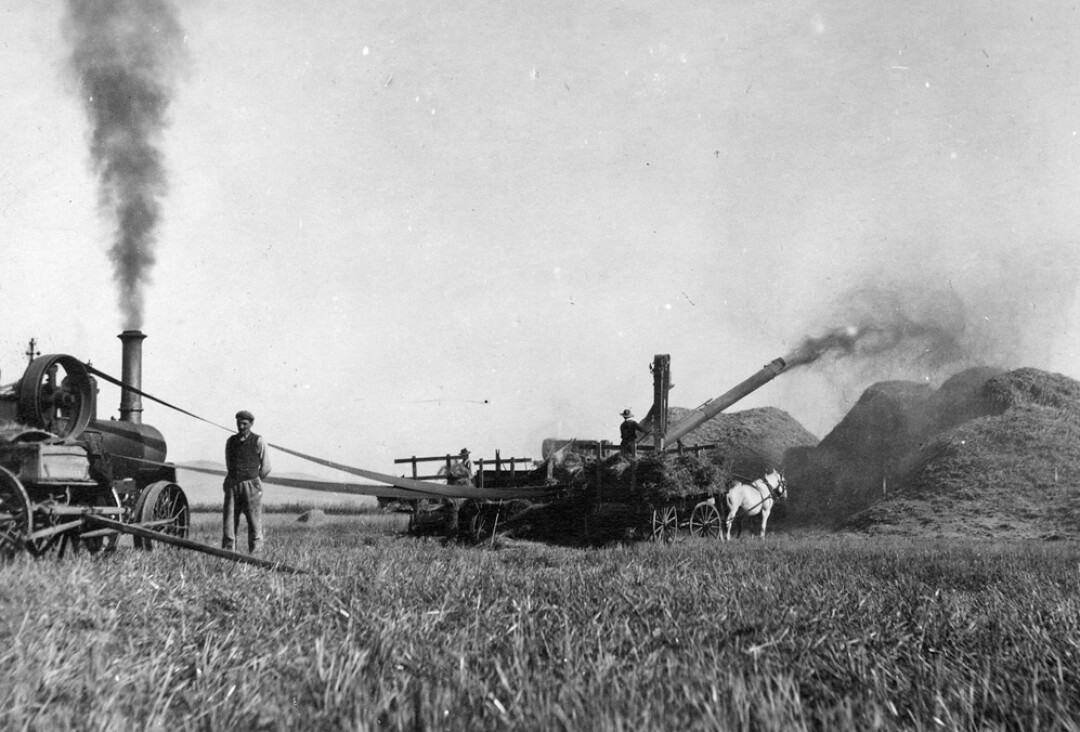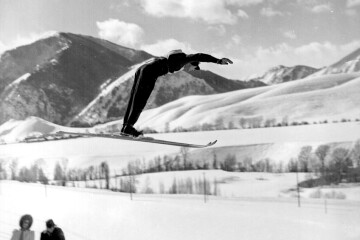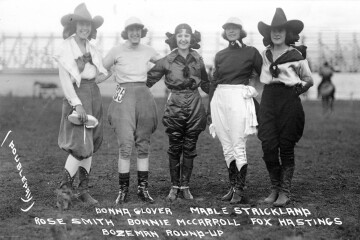HE was a SHE Manhattan’s Sammy Williams
Among the graves at Meadowview Cemetery, just south of Manhattan, Montana, sits a rather curious tombstone. The inscription reads: “A female whose real name is unknown but who has been for many years known as Sammy Williams. Died Dec. 10, 1908. Age about 68 yrs.” Curious as this epitaph may be, the life behind the words is even more intriguing.

The story begins not in Montana, but across the world in Hallingdal, Norway, perhaps in the 1830s, although no one is certain. Childhood friends Ingeborge Wekan and Sven Norem grew up together. As time passed, these school chums fell in love and were soon engaged to be married. It was at this time that Ingeborge’s parents decided to create a new life for themselves in America. The Wekans immigrated and settled in Allamakee County, Iowa, along with their daughter Ingeborge and her fiancé. Happy and anticipating her future life, Ingeborge began to sew her wedding clothes. Unfortunately, the happiness did not last. Sven’s mother, Mrs. Norem, broke off the engagement, claiming that Ingeborge and her family were not ranked high enough in society to become so closely connected with her son. Stricken with grief and a broken heart, Ingeborge Wekan disappeared.
Billy Williams was a small, delicate-looking man (maybe 5 feet tall), with jet-black hair, a feminine voice, and a slight hunchback. He appeared in Eau Claire, Wisconsin during the late 1850s or early 1860s, and quickly made many friends. Billy frequently went out with the lumberjacks, where he never hesitated to dance with the girls and spend his money. While he loved to drink and have a good time with his buddies, he was always careful never to become intoxicated. Word quickly spread about Billy’s talent as a cook, and nearby logging camps hired him without delay. As evidenced by his nickname, “Billy Cook” was considered at the top of his profession in Eau Claire, and consequently made quite a bit of money. Over the course of thirty years, Billy was able to purchase several buildings and lots in the city, a rare feat for most people of his class.
He was a smart man, and in addition to speaking Norwegian, English, and German fluently, Billy quickly picked up Indian languages during his time in the woods. But most of all, he was known for his generous nature. As reported later in Eau Claire’s Daily Telegram (reprinted in the Manhattan Record), “He was also of a very charitable turn of mind and there are those…who remember the kindly aids of a stranger who used to visit their homes and seeing indications of poverty, would leave five, ten and even fifteen dollars behind him without letting his identity be known.” Even after leaving Eau Claire sometime in the 1880s, Billy Williams sent gifts of money back to his friends who still resided there. The sick were never neglected when Billy was around – he made it a point to visit them and often stayed to nurse them through the night.
Given his rather feminine appearance, rumors began to circulate about Billy Williams’ true gender. Matters worsened when a Norwegian family, one that was familiar with Ingeborge’s parents back in Iowa, moved to Eau Claire and noticed Billy’s resemblance to Mrs. Wekan. Word reached her family, and Ingeborge’s brother was sent to Eau Claire to persuade “Billy” to return home. Her brother, of course, failed in his task. Independent though she was, Ingeborge must have missed her family. It is rumored that during her stay in Eau Claire, she made one last trip back to Iowa to observe her parents and to catch a glimpse of her former fiancé and his wife. Of course Ingeborge was dressed as a tramp and took care that none recognized her. After the encounter with her brother, however, Ingeborge decided it was time to leave Eau Claire. She sold her property and headed west to North Dakota, where she spent several years cooking for the Dalrymple farms.
Sometime later, Manhattan area horse and cattle rancher Henry Heeb found he was in need of a cook. His current help was getting on in years and wished to return home to China. One day in the early 1890s, Heeb stopped by the local saloon and struck up a conversation with a little man who had just jumped off a freight car. “Sammy” Williams (alias Ingeborge) was washing a few drinks down his travel-weary throat when he mentioned to Henry: “I cook good.” Williams was hired and spent the next 18 years in and around Manhattan, Montana, cooking for various ranch outfits, including the Heeb Ranch, the Meadowbrook Ranch, the Number I Ranch, and the Manhattan Company.
Sammy got along as well with the Montana cow hands as he did with the Wisconsin lumberjacks. He chewed tobacco and slept in the bunkhouse with the hired hands. It must have been hard for Sammy to hide his true identity while rooming with the men. One source claims he was the first to get up in the morning and the last to climb up to bed at night, changing his clothes in the dark while the others slept. Whatever lengths Ingeborge Wekan took to hide her sex are unknown, but her disguise must have been quite successful during her stay in Manhattan. There are no reports in the area of anyone thinking she was anything other than a man.

By the end of 1908, Sammy Williams’ health had begun to decline. Friends advised him to see a doctor after he expressed that he did not feel well. Of course, Sammy always brushed off this suggestion. There are several different reports of what happened next. One says that Sammy was stricken with a sudden heart attack one Thursday evening as he worked in the kitchen, and died a short while later. Another suggests hungry cowboys found him dead in his bunk after he failed to prepare their breakfast one morning. Others claimed that at the time of his death, Sammy was recovering from a drinking binge. However it happened, Undertaker George R. Safely was quite taken aback when he began to prepare Sammy Williams’ body for burial. As one can imagine, the fact that a woman would masquerade as a man caused quite a stir in town, and an inquest was conducted to determine the just reason for the charade. A local jeweler by the name of C. J. O’Dell believed that it was possible he had seen Williams many years before in Eau Claire, Wisconsin. He sent a letter of inquiry to Eau Claire’s police chief and later was able to learn all that was known about Sammy Williams’ life, as well as her real name.
Sammy Williams’ funeral was short and simple. The local Presbyterian minister, Rev. James Wallace MacGowan, spoke briefly, after which Billy/Sammy/Ingeborge was buried in the local cemetery. Sammy’s many friends all chipped in to purchase a headstone for her, though they were uncertain of her real name. At the time of her death, Ingeborge Wekan owned 320 acres of land outside of Manhattan. According to the Daily Telegram, Sammy was scheduled to sign a deed to this land on the day she died. Consequently, many believed that Sammy was finally planning to return home to Iowa to spend her remaining days with her relatives, but was too late.
Though not many of the details of Ingeborge Wekan’s life are known, what is certain is that, despite her hardships, she was a kind, caring person. She managed to make a vast number of friends in several states, who never forgot her kindness. As Eau Claire’s Daily Telegram stated: “And such is the sad life story of Ingeborge Wekan.” But, given the many friends she left behind, maybe her life did not end up to be such a sad story after all, just a different one.




